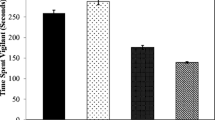Summary
Great tits (Parus major) tending nestlings reacted defensively to a live predator (Glaucidium perlatum; domestic cat) and the playback of a mixed species mobbing chorus, or to the latter alone. Defensive behaviour, mainly mobbing, reflected the risk taken and is assessed by five measures. Multivariate and contingency analyses revealed that at least 11 of 16 contextual independent variables affected the risk taken. Incremental effects are due to: Age of young, sex of the defending bird, the expected number of neighbouring mobbers, low temperature, wet canopy, the raptor's distance from cover, coniferous forest, advancing season. A decremental effect is exerted by a large brood that is older. Annual differences in defence arise probably from demographic factors such as fecundity, which in turn affect the parent's benefit-cost ratio (number of young of the same sex as the parent/residual reproductive value of the parent).
While the effects of annual fecundity, age of young and season were predicted on the basis of this benefit-cost ratio, the failure to verify an incremental effect of brood size runs counter to established theory. We conclude that parents gear their defence efforts to energy investment, past or future, and are mal-adapted to brood size as a promotor of risk taken. The influence of the habitat is poorly understood. At least three factors (age and number of young, parent's sex) act additively on part of the response. Despite the large number of variables examined, about 43% of the total response variance remains unexplained.
While four defence measures are determined by at least 10 contextual factors, a fifth measure, the male's minimum distance from the raptor, is determined by one other factor, the appearance of the ♀ male. The latter leads us to assume an additional, social rôle of brood defence.
Risk-assessment by great tits leading to risk-aversive defence behaviour is governed by evolved restraints rather than by momentary constraints. Examples are provided by the effects of weather and cover.
Similar content being viewed by others
References
Andersson M, Wiklund CG, Rundgren H (1980) Parental defence of offspring: a model and an example. Anim Behav 28:536–542
Balen JH van (1973) A comparative study of the breeding ecology of the great tit Parus major in different habitats. Ardea 61:1–93
Berndt R, Winkel W (1967) Die Gelegegröße des Trauerschnäppers (Ficedula hypoleuca) in Beziehung zu Ort, Zeit, Biotop und Alter. Vogelwelt 88:97–136
Beutel P (1980) Statistik-Programm-System für die Sozialwissenschaften: SPSS 8. Zahlreiche Tabellen und Beispiele von Beutel P, Küffner H, Schubö W. Nach Nie NH, Hull CH, 3rd edn. Fischer, Stuttgart New York
Bildstein KL (1982) Responses of northern harriers to mobbing passerines. J Field Ornithol 53:7–14
Chase ID (1980) Cooperative and noncooperative behavior in animals. Am Nat 115:827–857
Curio E (1975) The functional organization of anti-predator behaviour in the pied flycatcher: A study of avian visual perception. Anim Behav 23:1–115
Curio E (1978) The adaptive significance of avian mobbing. I. Teleonomic hypotheses and predictions. Z Tierpsychol 48:175–183
Curio E (1980) An unknown determinant of a sex-specific altruism. Z Tierpsychol 53:139–152
Curio E (1983a) Time-energy-budgets and optimization. Experientia 39:25–34
Curio E (1983b) Begehen Kohlmeisen den Concorde-Fehler? J Ornithol 124:196–198
Curio E, Regelmann K (1982) Fortpflanzungswert und “Brutwert” der Kohlmeise (Parus major). J Ornithol 123:237–257
Curio E, Augst HJ, Böcking HW, Milinski M, Ohguchi O (1978) Wie Singvögel auf Feindrufe hassen lernen. J Ornithol 119:231–233
Dawkins R, Carlisle TR (1976) Parental investment, mate desertion and a fallacy. Nature 262:131–133
Dooling RJ (1980) Behavior and psychophysics of hearing in birds. In: Popper AN, Fay RR (eds) Proceedings in life sciences. Comparative studies of hearing in vertebrates. Springer, Berlin Heidelberg New York, pp 261–288
Emlen JM (1970) Age specificity and ecological theory. Ecology 51:588–601
Gaensslen H, Schuboe W (1976) Einfache und komplexe statistische Analyse. Reinhardt, München Basel
Gibb J (1955) Feeding rates of great tits. Br Birds 48:49–58
Hamilton WD (1971) Geometry for the selfish herd. J Theor Biol 31:295–311
Herzog K (1968) Anatomie und Flugbiologie der Vögel. Fischer, Stuttgart
Hinde RA (1952) The behaviour of the great tit (Parus major) and some other related species. Behav (Suppl II) 1–201
Kluijver HN (1950) Daily routines of the great tit, Parus major L. Ardea 38:99–135
Kluijver HN (1951) The population of the great tit, Parus major L. Ardea 39:1–135
Latimer W (1977) A comparative study of the songs and alarm calls of some Parus species. Z Tierpsychol 45:414–433
Marten K, Marler P (1977) Sound transmission and its significance for animal vocalization. I. Temperate habitats. Behav Ecol Sociobiol 2:271–290
Nomoto S, Rautenberg W, Iriki M (1983) Temperature regulation during exercise in the Japanese quail (Coturnix coturnix japonica). J Comp Physiol 149:519–525
Perrins CM (1979) British tits. Collins, London
Robertson RJ, Biermann GC (1979) Parental investment strategies determined by expected benefits. Z Tierpsychol 50:124–128
Shalter MD (1979) Responses of nesting passerines to alarm calls. Ibis 121:362–368
Shedd DH (1982) Seasonal variation and function of mobbing and related antipredator behaviors of the American robin (Turdus migratorius). Auk 99:342–346
Smith JNM, Sweatman HPA (1974) Food-searching behaviour of titmice in patchy environments. Ecology 55:1216–1232
Sokal RR, Rohlf JF (1981) Biometry: The principles and practice of statistics in biological research, 2nd edn. Freeman, San Francisco, pp 617–778
Stearns SC (1976) Life-history tactics: a review of the ideas. Q Rev Biol 51:3–47
Weatherhead PJ (1982) Risk-taking by red-winged blackbirds and the Concorde Fallacy. Z Tierpsychol 60:199–208
Williams GC (1966) Natural selection, the costs of reproduction, and a refinement of Lack's principle. Am Nat 100:687–690
Winkel W (1970) Hinweise zur Art- und Altersbestimmung von Nestlingen höhlenbrütender Vogelarten anhand ihrer Körperentwicklung. Vogelwelt 91:52–59
Winkel W, Winkel D (1981) Zum Paarzusammenhalt bei Kohl-, Blau- und Tannenmeise (Parus major, P. caeruleus und P. ater). Vogelwarte 30:325–333
Author information
Authors and Affiliations
Rights and permissions
About this article
Cite this article
Regelmann, K., Curio, E. Determinants of brood defence in the great tit Parus major L.. Behav Ecol Sociobiol 13, 131–145 (1983). https://doi.org/10.1007/BF00293803
Received:
Accepted:
Issue Date:
DOI: https://doi.org/10.1007/BF00293803




